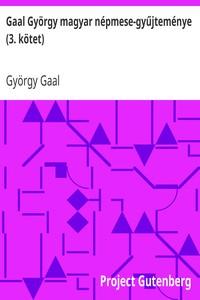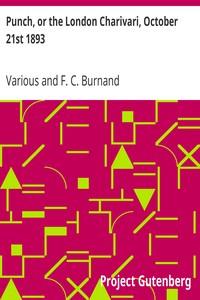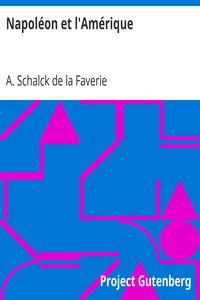|
|
Read this ebook for free! No credit card needed, absolutely nothing to pay.Words: 170767 in 22 pages
This is an ebook sharing website. You can read the uploaded ebooks for free here. No credit cards needed, nothing to pay. If you want to own a digital copy of the ebook, or want to read offline with your favorite ebook-reader, then you can choose to buy and download the ebook.

: Encyclopaedia Britannica 11th Edition Hero to Hindu Chronology Volume 13 Slice 4 by Various - Encyclopedias and dictionaries@FreeBooksWed 07 Jun, 2023 orthumberland, but not till 1847, nine years after the author's return to England, for the cogent reason, that as he said, "The whole of the observations, as well as the entire work of reducing, arranging and preparing them for the press, have been executed by myself." There are 164 pages of catalogues of southern nebulae and clusters of stars. There are then careful and elaborate drawings of the great nebula in Orion, and of the region surrounding the remarkable star in Argo. The labour and the thought bestowed upon some of these objects are almost incredible; several months were spent upon a minute spot in the heavens containing 1216 stars, but which an ordinary spangle, held at a distance of an arm's length, would eclipse. These catalogues and charts being completed, he proceeded to discuss their significance. He confirmed his father's hypothesis that these wonderful masses of glowing vapours are not irregularly scattered over the visible heavens, but are collected in a sort of canopy, whose vertex is at the pole of that vast stratum of stars in which our solar system finds itself buried, as Herschel supposed, at a depth not greater than that of the average distance from us of an eleventh magnitude star. Then follows his catalogue of the relative positions and magnitudes of the southern double stars, to one of which, Virginis, he applied the beautiful method of orbital determination invented by himself, and he had the satisfaction of witnessing the fulfilment of his prediction that the components would, in the course of their revolution, appear to close up into a single star, inseparable by any telescopic power. In the next chapter he proceeded to describe his observations on the varying and relative brightness of the stars. It has been already detailed how his father began his scientific career by similar observations on stellar light-fluctuations, and how his remarks culminated years afterwards in the question whether the radiative changes of our sun, due to the presence or absence of sun-spots, affected our harvests and the price of corn. Sir John carried speculation still farther, pointing out that variations to the extent of half a magnitude in the sun's brightness would account for those strange alternations of semi-arctic and semi-tropical climates which geological researches show to have occurred in various regions of our globe. A complete list of his contributions to learned societies will be found in the Royal Society's great catalogue, and from them may be gathered most of the records of his busy scientific life. Sir John Herschel met with an amount of public recognition which was unusual in the time of his illustrious father. Naturally he was a member of almost every important learned society in both hemispheres. For five years he held the same office of master of the mint, which more than a century before had belonged to Sir Isaac Newton; his friends also offered to propose him as president of the Royal Society and again as member of parliament for the university of Cambridge, but neither position was desired by him. In private life Sir John Herschel was a firm and most active friend; he had no jealousies; he avoided all scientific feuds; he gladly lent a helping hand to those who consulted him in scientific difficulties; he never discouraged, and still less disparaged, men younger than or inferior to himself; he was pleased by appreciation of his work without being solicitous for applause; it was said of him by a discriminating critic, and without extravagance, that "his was a life full of serenity of the sage and the docile innocence of a child." He died at Collingwood, his residence near Hawkhurst in Kent, on the 11th of May 1871, in the seventy-ninth year of his age, and his remains are interred in Westminster Abbey close to the grave of Sir Isaac Newton. HERSCHELL, FARRER HERSCHELL, 1ST BARON , lord chancellor of England, was born on the 2nd of November 1837. His father was the Rev. Ridley Haim Herschell, a native of Strzelno, in Prussian Poland, who, when a young man, exchanged the Jewish faith for Christianity, took a leading part in founding the British Society for the Propagation of the Gospel among the Jews, and, after many journeyings, settled down to the charge of a Nonconformist chapel near the Edgware Road, in London, where he ministered to a large congregation. His mother was a daughter of William Mowbray, a merchant of Leith. He was educated at a private school and at University College, London. In 1857 he took his B.A. degree at the University of London. He was reckoned the best speaker in the school debating society, and he displayed there the same command of language and lucidity of thought which were his characteristics during his official life. The reputation which Herschell enjoyed during his school days was maintained after he became a law-student at Lincoln's Inn. In 1858 he entered the chambers of Thomas Chitty, the famous common law pleader, father of the late Lord Justice Chitty. His fellow pupils, amongst whom were A. L. Smith, afterwards master of the rolls, and Arthur Charles, afterwards judge of the queen's bench division, gave him the sobriquet of "the chief baron" in recognition of his superiority. He subsequently read with James Hannen, afterwards Lord Hannen. In 1860 he was called to the bar and joined the northern circuit, then in its palmy days of undividedness. For four or five years he did not obtain much work. Fortunately, he was never a poor man, and so was not forced into journalism, or other paths of literature, in order to earn a living. Two of his contemporaries, each of whom achieved great eminence, found themselves in like case. One of these, Charles Russell, became lord chief justice of England; the other, William Court Gully, speaker of the House of Commons. It is said that these three friends, dining together during a Liverpool assize some years after they had been called, agreed that their prospects were anything but cheerful. Certain it is that about this time Herschell meditated quitting England for Shanghai and practising in the consular courts there. Herschell, however, soon made himself useful to Edward James, the then leader of the northern circuit, and to John Richard Quain, the leading stuff-gownsman. For the latter he was content to note briefs and draft opinions, and when, in 1866, Quain donned "silk," it was on Herschell that a large portion of his mantle descended. Herschell's public services from 1880 to 1885 were of great value, particularly in dealing with the "cases for opinion" submitted by the Foreign Office and other departments. He was also very helpful in speeding government measures through the House, notably the Irish Land Act 1881, the Corrupt Practices and Bankruptcy Acts 1883, the County Franchise Act 1884 and the Redistribution of Seats Act 1885. This last was a bitter pill for Herschell, since it halved the representation of Durham city, and so gave him statutory notice to quit. Reckoning on the local support of the Cavendish family, he contested the North Lonsdale division of Lancashire; but in spite of the powerful influence of Lord Hartington, he was badly beaten at the poll, though Mr Gladstone again obtained a majority in the country. Herschell now thought he saw the solicitor-generalship slipping away from him, and along with it all prospect of high promotion. Lord Selborne and Sir Henry James, however, successively declined Gladstone's offer of the Woolsack, and in 1886 Herschell, by a sudden turn of fortune's wheel, found himself in his forty-ninth year lord chancellor. Herschell's chancellorship lasted barely six months, for in August 1886 Gladstone's Home Rule Bill was rejected in the Commons and his administration fell. In August 1892, when Gladstone returned to power, Herschell again became lord chancellor. In September 1893, when the second Home Rule Bill came on for second reading in the House of Lords, Herschell took advantage of the opportunity to justify the "sudden conversion" to Home Rule of himself and his colleagues in 1885 by comparing it to the duke of Wellington's conversion to Catholic Emancipation in 1829 and to that of Sir Robert Peel to Free Trade in 1846. In 1895, however, his second chancellorship came to an end with the defeat of the Rosebery ministry. HERSFELD, a town of Germany, in the Prussian province of Hesse-Nassau, is pleasantly situated at the confluence of the Geis and Haun with the Fulda, on the railway from Frankfort-on-Main to Bebra, 24 m. N.N.E. of Fulda. Pop. 8688. Some of the old fortifications of the town remain, but the ramparts and ditches have been laid out as promenades. The principal buildings are the Stadt Kirche, a beautiful Gothic building, erected about 1320 and restored in 1899, with a fine tower and a large bell; the old and interesting town hall and the ruins of the abbey church. This church was erected on the site of the cathedral in the beginning of the 12th century; it was built in the Byzantine style and was burnt down by the French in 1761. Outside the town are the Frauenberg and the Johannesberg, on both of which are monastic ruins. Among the public institutions are a gymnasium and a military school. The town has important manufactures of cloth, leather and machinery; it has also dye-works, worsted mills and soap-boiling works. Hersfeld owes its existence to the Benedictine abbey . It became a town in the 12th century and in 1370 the burghers, having meanwhile shaken off the authority of the abbots, placed themselves under the protection of the landgraves of Hesse. It was taken and retaken during the Thirty Years' War and later it suffered from the attacks of the French. The Benedictine abbey of Hersfeld was founded by Lullus, afterwards archbishop of Mainz, about 769. It was richly endowed by Charlemagne and became an ecclesiastical principality in the 12th century, passing under the protection of the landgraves of Hesse in 1423. It was secularized in 1648, having been previously administered for some years by a member of the ruling family of Hesse. As a secular principality Hersfeld passed to Hesse, and with electoral Hesse was united with Prussia in 1866. In the middle ages the abbey was famous for its library. HERTFORD, a market-town and municipal borough, and the county town of Hertfordshire, England, in the Hertford parliamentary division of the county, 24 m. N. from London, the terminus of branch lines of the Great Eastern and Great Northern railways. Pop. 9322. It is pleasantly situated in the valley of the river Lea. The chief buildings are the modern churches of St Andrew and of All Saints, on the sites of old ones, a town hall, corn exchange, public library, school of art and the old castle, which retains the wall and part of a tower dating from the Norman period, and is represented by a picturesque Jacobean building of brick, largely modernized. There are several educational establishments, including the preparatory school for Christ's Hospital, a picturesque building at the east end of the town, Hale's grammar school, the Cowper Testimonial school, and a Green-coat school for boys and girls. Two miles S.E. is Haileybury College, one of the principal public schools of England, founded in 1805 by the East India Company for their civil service students, who were then temporarily housed in Hertford Castle. The school lies high above the Lea valley, towards Hoddesdon, in the midst of a stretch of finely-wooded country. Hertford has a considerable agricultural trade, and there are maltings, breweries, iron foundries, and oriental printing works. The town is governed by a mayor, 5 aldermen and 15 councillors. Area, 1134 acres. HERTFORDSHIRE , a county of England, bounded N. by Cambridgeshire, N.W. by Bedfordshire, E. by Essex, S. by Middlesex, and S.W. by Buckinghamshire. The area is 634.6 sq. m., the county being the sixth smallest in England. Its aspect is always pleasant, the surface generally undulating, while in some parts, where these undulations form a quick succession of hills and valleys, the woodland scenery becomes very beautiful, as in the upper Lea valley, in the neighbourhood of Tewin near Hertford, and elsewhere. To the north-west and north considerable elevations are reached, a line of hills, facing north-westward with a sharp descent, crossing this portion of the county, and overlooking the flat lands of Bedfordshire and Cambridgeshire. They continue the line of the Chiltern Hills under the name of the East Anglian Ridge. They exceed 800 ft. near Dunstable, sinking gradually north-eastward. These uplands are generally bare, and in parts remarkably sparsely populated as compared with the home counties at large. In the greater part of the county, however, rich arable lands are intermingled with the parks and woodlands of numerous fine country seats, which impart to the county a peculiar luxuriance. Of the principal rivers, the Lea, rising beyond Luton in Bedfordshire, enters Hertfordshire near East Hyde, flows S.E. to near Hatfield, then E. by N. to Hertford and Ware, whence it bends S. and passing along the eastern boundary of the county falls into the Thames below London. It receives in its course the Maran, or Mimram, the Beane, the Rib and the Stort, all joining on the north side; the Stort for some distance forming the county boundary with Essex. The Colne flows through the south-western part of the county, to fall into the Thames at Staines. It receives the Ver, the Bulborne and the Chess. The Ivel, rising in the N.W. soon passes into Bedfordshire to join the Great Ouse. To the south of Hatfield, near North Mimms, two streams of moderate size are lost in pot-holes, except in the highest floods. The New River, one of the water supplies of London, has its source near Ware, and runs roughly parallel with the Lea. Most of the rivers are full of fish, including trout in the upper parts , which are carefully preserved. Free books android app tbrJar TBR JAR Read Free books online gutenberg More posts by @FreeBooks
: Gaal György magyar népmese-gyűjteménye (3. kötet) by Gaal Gy Rgy - Tales Hungary; Folk literature Hungarian@FreeBooksWed 07 Jun, 2023

: Punch or the London Charivari October 21st 1893 by Various Burnand F C Francis Cowley Editor - English wit and humor Periodicals Punch@FreeBooksWed 07 Jun, 2023
|
Terms of Use Stock Market News! © gutenberg.org.in2025 All Rights reserved.






